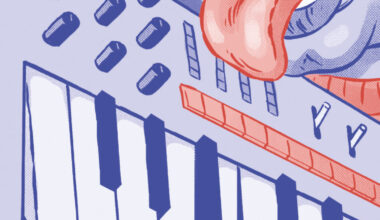Say there was someone, and he (or she) was sending us weird rambling emails and despite asking, he (or she) wouldn’t stop. We should call the police, Right? Anyway, here’s whatshisface

When you jab a synthesiser, a sound plops out. This process seems complex to stupid people like you, but it’s quite simple to expert music experts like me. Here’s what happens when you jab a synthesiser. Your finger pokes a key, which tickles the internal tubes. The tubes make a surprised noise, and this falls out of the speaker in the shape of an envelope. To normal people who own suburban water features and Renault Clios and bowl-haired children, “envelope” is the name of the junk mail that’s rammed through their letterbox on a daily basis.
To expert music experts like me, “envelope” describes how dynamic a musical note is. For example, some notes are not dynamic. They plonk miserably, like a piano at a dentist. Other notes are very dynamic indeed, like an orchestra being chased by a sexy axe murderer. These differing “envelopes” can be measured with four parameters: attack, decay, sustain and release.
The “attack” is the beginning of the note. Imagine climbing into bed after a long day serving beef flaps at Gregg’s. You pull your Harry Styles duvet tight and nuzzle your teddy bear Susan, her plastic eyes long since stolen by spiders. As you drift into sleep, I pounce from a wardrobe and bite your face off. “Why me?!” you try to scream, but you can’t because I’ve literally eaten your face. This is called an “attack” and it is what happens at the start of a note.
“Decay” is the second bit of the note. It’s the brief aftershock; the echo following a quake; the face of a kitten after you show it a photograph of Ann Widdecombe. To normal people who own suburban children features and bowl-haired Clios, “decay” is what happens to pensions after investing in too much organic kale. Personally, I’ve replaced my hopes and dreams with bitcoins because I am, like, the new Elon Musk or something.
The next two parts of a note are called “sustain” and “release”. Vegan-faced rainforest musician Sting is great at sustaining notes. He can sustain a note for days while grasping a chastity belt with his hairy palms. Meanwhile, the one-man YMCA tribute act George Michael was amazing at releasing, especially over hastily scrawled phone numbers on the walls of public toilets. This section of “jokes” is sponsored by the 1990s. Thanks, 1990s.
Synthesisers have other buttons that make notes do stuff and that. There is “resonance” which will summon the spirit of a trendy radio station. There is “cut off which describes the type of demin shorts I sport when slapping down a sick bassline. And there is “bossa nova” which… actually, I don’t know what that does. No one knows what the bossa nova button does. DO NOT PRESS THE BOSSA NOVA BUTTON.
We’ve all learnt something this month because I am an expert music expert. Much of this applies to physical synthesisers, the type that you can carry under your arm or let clog with dust in your ironing board cupboard. There are also “soft synths” which are made of digital where you email your notes to AltaVista for approval. This is something modern kids are into. They make notes on fidget spinners while skateboarding over Tamagotchis. Stupid kids. If it’s not actual fingers poking keys that make envelopes fall out of tubes, I’m not interested.





